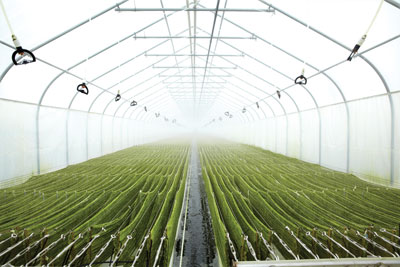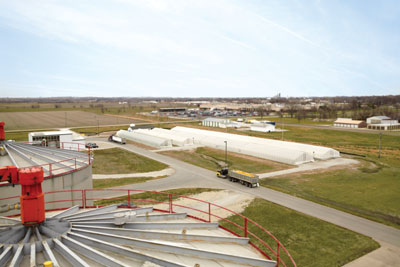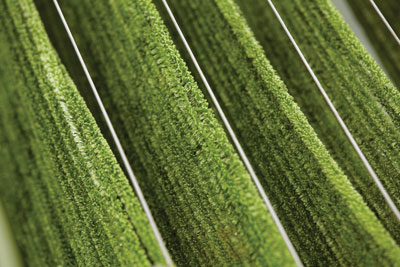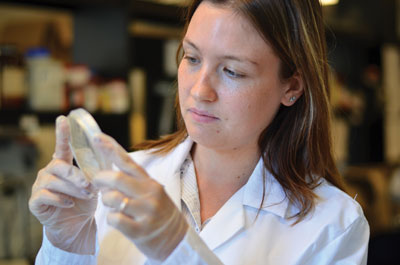
From Slime to Dollar Signs?
March 27, 2013
By Stefanie Wallace
The biomass world has high hopes for algae, and rightfully so: some of the thousands of strains of the slimy substance have great potential to become a sustainable source of biomass and the next big biofuel.
The biomass world has high hopes for algae, and rightfully so: some of the thousands of strains of the slimy substance have great potential to become a sustainable source of biomass and the next big biofuel. But with great potential comes great challenge, and there is still much work and research to be done before algae can be called the next panacea and renewable resource.
 |
|
| Algae growing in one of BioProcess Algae’s Grower Harvesters. The company’s CEO says this technology is similar to a crop-based system. Photo: BioProcess Algae/Green Plains Renewable Energy
|
Algae can be categorized into two main types: macroalgae, more commonly known as seaweed, and microalgae, the microscopic organisms that live in water. Light, carbon dioxide and nutrients are necessary for algae growth, which happens via photosynthesis. Algal cultivation methods vary, with primary means of growth including an open pond, a photobioreactor, and a hybrid method.
The open pond method works best in hot, sunny climates, as bad weather can stunt algae growth. However, in an open pond, algae are at risk of contamination from bacteria, and the water must be kept at a certain temperature, which could be challenging to maintain. A photobioreactor is a closed system that prevents bacterial contamination, and generally grows algae quicker than an open pond.
Carbon Neutral
Regardless of how they are cultivated, algae require light and carbon dioxide to successfully grow. Because of this, carbon conversion projects have shown promise to become sustainable ways of growing algal biomass. “All of the different species of algae love to scrub; they love to clean pollutants and toxins out of the air and from water,” says Sean O’Hanlon, an American algae enthusiast and the founder and CEO of the American Biofuels Council. With carbon dioxide molecules clinging to algae instead of being released into the atmosphere, this can be a great way to reduce greenhouse gas emissions.
 |
|
| BioProcess Algae’s Grower Harvester algae bioreactors at the Green Plains Renewable Energy ethanol plant in Shenandoah, Iowa, were inoculated last October and are fully operational and producing algae. Photos: BioProcess Algae/Green Plains Renewable Energy
|
Once grown, the algae must be separated from the water before oils from the algae can be extracted and converted into biofuel. The residual biomass left has a number of uses, including fertilizer, biochar and animal feed. What’s more, O’Hanlon adds, algae are essentially carbon neutral. When burned, the algae will emit carbon, but they absorb much more carbon while they grow: roughly two pounds of carbon dioxide are required to produce one pound of algae. “No matter how much algae you produce, and how much you burn, you aren’t going to burn more than you’re using,” he says. This factor makes the process especially appealing to companies who are trying to reduce their carbon footprint.
Companies such as Pond Biofuels, based in Toronto, have capitalized on industrial smokestacks to feed carbon dioxide directly into a photobioreactor to grow algae. Pond Biofuels did not respond to multiple interview requests, but the CBC reported in December that Pond Biofuels has partnered with U.S. Steel in Nanticoke, Ont., in addition to a previous partnership with St Marys Cement in St. Marys, Ont. By tapping into the companies’ smokestacks, Steve Martin, the CEO of Pond Biofuels, says both U.S. Steel and St. Marys Cement are helping keep greenhouse gas emissions out of the atmosphere while producing biomass and biofuel.
Even with the carbon dioxide component covered, light can be a major obstacle to large-scale commercialization, especially in Canada where the climate isn’t ideal to grow algae. Artificial light can be an option to supplement natural sunlight, but could this hinder sustainability?
Algae-Focused Research
Enter the researchers. Dr. David Levin is a researcher at BioFuelNet, a network of researchers from 25 Canadian universities, partnering with industry and government, and focused on developing processes to create next-generation biofuels from biomass. Levin, based in Winnipeg, leads the prairie platform in Manitoba, which focuses on microbial conversion of biomass to next-generation biofuels, primarily drop-in fuels that have chemical properties similar to petroleum-derived fuels.
 |
|
| Researchers at BioFuelNet are working to find a cold-hardy strain of algae that is easier to grow in northern climates.
|
There are eight researchers working on algae-related projects within BioFuelNet, with research focusing on areas such as using plant hormones to stimulate algae growth, determining how to stimulate cells to grow at a higher density (thus stimulating higher production of oil), finding novel ways to extract oil from the cells and finding cold-adapted strains of algae that produce lots of biomass at lower temperatures. Levin summarizes the reasoning behind the research simply: “We’re doing algae work largely because everyone else in the world is focused on algae.”
Levin recognizes algae’s potential doesn’t come without major challenges, particularly climate. “You can’t grow algae in outdoor ponds in the winter in Canada,” he says. “So how do you grow it in a photobioreactor indoors, where you can control the temperature and the light and still have high levels of productivity in terms of biomass, and high levels of production of the product of interest – the oils?”
A northern climate isn’t idea for algae growth, but one company has found a way to work around the weather. Based out of Portsmouth, R.I., BioProcess Algae has developed a hybrid production system called Grower Harvester technology. Tim Burns, the CEO of BioProcess Algae, describes the crop-based technology as an industrialized greenhouse bioreactor that grows algae without water. The company is working on carbon utilization projects in Ohio and Pennsylvania, and has been running a demonstration plant at Green Plains Renewable Energy, an ethanol facility in Shenandoah, Iowa, since October 2009. The bioreactor taps into Green Plains’ fermentation process and waste heat to feed into the Grower Harvesters. On a one-acre area, Burns says, the reactors house about 40 times the surface area of open ponds growing algae in Hawaii. The reactors are seeded, similar to planting, and carbon dioxide waste heat is introduced.
Because the Grower Harvesters are phototrophic systems, sunlight is necessary, and Burns recognizes that steady sunlight during an Iowa winter isn’t a given. He doesn’t believe in using artificial light: “Artificial light creates more carbon dioxide than could ever be removed,” Burns says. Further, the economics don’t support supplementing with artificial light, as the cost of lighting outweighs the return. “You’d have to be in exotic products with small niche markets; nutraceuticals, for instance.”
Instead, BioProcess Algae works with whatever sunlight it has, and adapts its expectations – and processes – to meet reality. Harvesting happens more often in the summer, every day or every second day. In the winter, harvesting occurs every five to seven days. “Because you have different Grower Harvesters, it almost becomes a continued system,” Burns says. “Each day you might be harvesting a different row or reactor.” With monocultures like soybean and corn, only one crop season is present, and a summer heatwave or the onset of disease presents challenges. “With algae you can plant and replant and put a new strain in and grow a different crop.”
Commercialization and Integration
In terms of commercialization, the protein market is the main focus of BioProcess Algae, but Burns says producing biofuel is a long-term goal.
 |
|
| Researchers at BioFuelNet are working on different algae-related projects, including finding cold-adapted strains of algae that produce lots of biomass at lower temperatures. Photo: BioFuelNet
|
“In the United States, they’re moving ahead with commercialization in a big way,” Levin of BioFuelNet says, referring to such companies as Solazyme (based in California) and Sapphire Energy (working out of California and New Mexico), who are growing large quantities of algae for large-scale algae jet fuel projects for commercial and military uses.
On a smaller, local scale, Levin sees disconnect in terms of the need for fuels and the value of fuel as a product, compared to the value of other algae-related products. “Everything depends on the price of oil,” Levin says. “When oil is at $80 per barrel, alternative energies aren’t very competitive. When the price jumps to $120 per barrel, all bets are off – there might be a market for algae biofuel. It’s a difficult thing to resolve until the demand is much higher and you can compete. Right now, it’s not very competitive.”
Levin says the market will also depend on economic incentives. “If there’s a carbon cap-and-trade, then carbon capture and displacement of fossil fuel combustion becomes economically important. But it’s not likely that we’ll have this in Canada, so these projects become more focused on greenhouse gas reduction.”
In Levin’s eyes, algae’s real potential is in integration – a system that incorporates several end uses from algae will be most profitable. “The idea of just growing algae and making one product is not going to be economically viable. You need to have high-value products to offset the low-value products.”
Meantime, it’s safe to say the push for algae biofuel isn’t letting up any time soon. Researchers will continue to search for a cold-hardy strain, and companies will continue to develop carbon conversion projects. But in a way, Levin’s perspective sums up algae’s long-term potential: where light and carbon dioxide are necessary for algae’s growth, a demand for the product is necessary for its commercial success.
Print this page